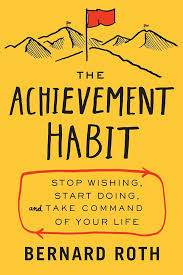White Paper
The Achievement Habit: A Framework for Personal and Professional Success
Author:
- IAS-Research.com
Abstract
Bernard Roth's The Achievement Habit offers a comprehensive framework for personal and professional success, focusing on the importance of taking action and overcoming procrastination. This white paper provides a summary of the key concepts presented in the book, along with additional insights and applications. We explore the power of doing, overcoming excuses, developing a doer mindset, building resilience, and leveraging design thinking principles to achieve your goals.
Introduction
In today's fast-paced world, achieving success requires more than just talent or intelligence; it also necessitates a proactive and persistent mindset. The Achievement Habit by Bernard Roth offers a valuable framework for cultivating such a mindset. By emphasizing the importance of taking action, overcoming excuses, and developing a doer mindset, Roth provides readers with practical strategies for achieving their goals.
Key Concepts from The Achievement Habit
- The Power of Doing: Roth argues that merely wishing for something is not enough; you must take action and do the work to achieve your goals. By focusing on doing, rather than simply thinking or planning, you can make significant progress towards your objectives.
- Overcoming Excuses: Excuses are often used to justify inaction and avoid discomfort. Roth encourages readers to identify and challenge excuses that hold them back from taking action. By recognizing and addressing these excuses, you can free yourself to pursue your goals with greater determination.
- Developing a Doer Mindset: A doer mindset is characterized by a belief in your ability to achieve your goals and a willingness to take action. By cultivating a doer mindset, you can overcome self-doubt and procrastination, and approach challenges with greater confidence.
- Building Resilience: Setbacks and failures are inevitable on the path to success. Roth emphasizes the importance of building resilience, the ability to bounce back from adversity and continue moving forward. By developing resilience, you can persevere through challenges and maintain your motivation.
- Leveraging Design Thinking: Design thinking is a problem-solving approach that involves empathy, definition, ideation, prototyping, and testing. Roth suggests that design thinking can be applied to personal and professional goals, helping you to identify problems, generate creative solutions, and iterate towards success.
Applications of The Achievement Habit
- Personal Goal Setting: The principles outlined in The Achievement Habit can be applied to setting and achieving personal goals, such as improving your health, learning a new skill, or starting a business.
- Professional Development: The book's emphasis on taking action and overcoming excuses can be valuable for career advancement. By proactively pursuing opportunities and overcoming obstacles, you can increase your chances of success.
- Team Building: The concepts of teamwork and collaboration are central to The Achievement Habit. By applying these principles to team settings, you can foster a more productive and collaborative work environment.
- Leadership Development: Effective leaders must be able to inspire and motivate others. The book's focus on taking action and overcoming challenges can be helpful for developing leadership skills.
Conclusion
The Achievement Habit offers a comprehensive framework for personal and professional success. By understanding and applying the key concepts presented in the book, you can develop a more proactive and successful mindset. Whether you are striving to achieve personal goals or advance your career, the principles outlined in The Achievement Habit can provide valuable guidance.
References
- The Achievement Habit by Bernard Roth. Crown Business, 2018.
Additional Resources
- Stanford Graduate School of Business: https://www.gsb.stanford.edu/
- Bernard Roth's Website: [invalid URL removed]
Note: This white paper provides a summary and analysis of The Achievement Habit. For a more in-depth understanding of the book's concepts, it is recommended to read the original text.contact ias-research.com



